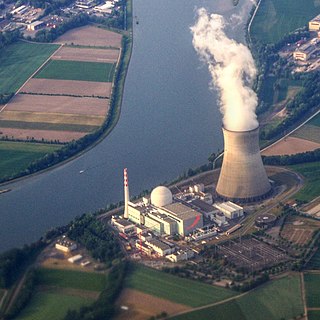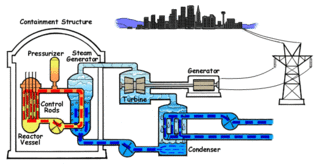Related Research Articles

The Defense Advanced Research Projects Agency (DARPA) is a research and development agency of the United States Department of Defense responsible for the development of emerging technologies for use by the military. Originally known as the Advanced Research Projects Agency (ARPA), the agency was created on February 7, 1958, by President Dwight D. Eisenhower in response to the Soviet launching of Sputnik 1 in 1957. By collaborating with academia, industry, and government partners, DARPA formulates and executes research and development projects to expand the frontiers of technology and science, often beyond immediate U.S. military requirements. The name of the organization first changed from its founding name, ARPA, to DARPA, in March 1972, changing back to ARPA in February 1993, then reverted to DARPA in March 1996.

Nuclear power is the use of nuclear reactions to produce electricity. Nuclear power can be obtained from nuclear fission, nuclear decay and nuclear fusion reactions. Presently, the vast majority of electricity from nuclear power is produced by nuclear fission of uranium and plutonium in nuclear power plants. Nuclear decay processes are used in niche applications such as radioisotope thermoelectric generators in some space probes such as Voyager 2. Reactors producing controlled fusion power have been operated since 1958 but have yet to generate net power and are not expected to be commercially available in the near future.

Spacecraft propulsion is any method used to accelerate spacecraft and artificial satellites. In-space propulsion exclusively deals with propulsion systems used in the vacuum of space and should not be confused with space launch or atmospheric entry.

The Strategic Defense Initiative (SDI), derisively nicknamed the Star Wars program, was a proposed missile defense system intended to protect the United States from attack by ballistic nuclear missiles. The program was announced in 1983, by President Ronald Reagan. Reagan called for a system that would render nuclear weapons obsolete, and to end the doctrine of mutual assured destruction (MAD), which he described as a "suicide pact". Elements of the program reemerged in 2019 under the Space Development Agency (SDA).

A nuclear thermal rocket (NTR) is a type of thermal rocket where the heat from a nuclear reaction replaces the chemical energy of the propellants in a chemical rocket. In an NTR, a working fluid, usually liquid hydrogen, is heated to a high temperature in a nuclear reactor and then expands through a rocket nozzle to create thrust. The external nuclear heat source theoretically allows a higher effective exhaust velocity and is expected to double or triple payload capacity compared to chemical propellants that store energy internally.

A fusion rocket is a theoretical design for a rocket driven by fusion propulsion that could provide efficient and sustained acceleration in space without the need to carry a large fuel supply. The design requires fusion power technology beyond current capabilities, and much larger and more complex rockets.
Environmental science is an interdisciplinary academic field that integrates physics, biology, meteorology, mathematics and geography to the study of the environment, and the solution of environmental problems. Environmental science emerged from the fields of natural history and medicine during the Enlightenment. Today it provides an integrated, quantitative, and interdisciplinary approach to the study of environmental systems.

Nuclear pulse propulsion or external pulsed plasma propulsion is a hypothetical method of spacecraft propulsion that uses nuclear explosions for thrust. It originated as Project Orion with support from DARPA, after a suggestion by Stanislaw Ulam in 1947. Newer designs using inertial confinement fusion have been the baseline for most later designs, including Project Daedalus and Project Longshot.

Argonne National Laboratory is a federally funded research and development center in Lemont, Illinois, United States. Founded in 1946, the laboratory is owned by the United States Department of Energy and administered by UChicago Argonne LLC of the University of Chicago. The facility is the largest national laboratory in the Midwest.

Nuclear propulsion includes a wide variety of propulsion methods that use some form of nuclear reaction as their primary power source. The idea of using nuclear material for propulsion dates back to the beginning of the 20th century. In 1903 it was hypothesized that radioactive material, radium, might be a suitable fuel for engines to propel cars, planes, and boats. H. G. Wells picked up this idea in his 1914 fiction work The World Set Free. Many aircraft carriers and submarines currently use uranium fueled nuclear reactors that can provide propulsion for long periods without refueling. There are also applications in the space sector with nuclear thermal and nuclear electric engines which could be more efficient than conventional rocket engines.
Future Fantastic was a British documentary television series which premiered in 1996. This show looked at the how science and science fiction complement each other, and how ideas and technologies from the past are helping to shape our future. The series was narrated by Gillian Anderson and co-produced by the British Broadcasting Corporation, The Learning Channel and Pro Sieben.
Jerome Pearson was an American engineer and space scientist best known for his work on space elevators, including a lunar space elevator. He was president of STAR, Inc., and has developed aircraft and spacecraft technology for the United States Air Force, DARPA, and NASA. He held several patents and was the author of nearly 100 publications in aircraft, spacecraft, electrodynamic tethers, SETI, and global climate control.
The National Institute of Aerospace (NIA) is a non-profit research and graduate education institute headquartered in Hampton, Virginia, near NASA's Langley Research Center.

The Chief Scientist of the Air Force is the most senior science and technology representative in the United States Department of the Air Force. The current Chief Scientist of the United States Air Force is Victoria Coleman, sworn in on April 6, 2021.

Sachchida Nand Tripathi is an Indian scientist who works in the field of Atmospheric Sciences. He is the Dean of Kotak School of Sustainability and Professor in the Department of Civil Engineering and the Department of Sustainable Energy Engineering at Indian Institute of Technology, Kanpur.

Since its establishment in 1958, NASA has conducted research on a range of topics. Because of its unique structure, work happens at various field centers and different research areas are concentrated in those centers. Depending on the technology, hardware and expertise needed, research may be conducted across a range of centers.

Stephen Joseph Lukasik was an American physicist who served in multiple high-level defense and scientific related positions for advancing the technologies and techniques for national defense and the detection and control of diverse types of weapons of mass destruction, especially nuclear devices. He was the second longest serving Director of DARPA - the Defense Advanced Research Projects Agency – during which numerous new technologies including packet and internet protocols were developed. He was also the first chief scientist of the Federal Communications Commission where he created its Office of Science and Technology and which facilitated the commercial deployment of new technology that included spread spectrum technology.

Salvatore Cezar Pais is a Romanian-American aerospace engineer and inventor, currently working for the United States Space Force. He formerly worked at the Naval Air Station Patuxent River. His patent applications for the US Navy attracted attention for their potential energy-producing applications, but also doubt about their feasibility, and speculation that they may be scams, pseudoscience, or disinformation intended to mislead the United States' adversaries.

Scenarios in which a global catastrophic risk creates harm have been widely discussed. Some sources of catastrophic risk are anthropogenic, such as global warming, environmental degradation, and nuclear war. Others are non-anthropogenic or natural, such as meteor impacts or supervolcanoes. The impact of these scenarios can vary widely, depending on the cause and the severity of the event, ranging from temporary economic disruption to human extinction. Many societal collapses have already happened throughout human history.

The Demonstration Rocket for Agile Cislunar Operations (DRACO) is an under-development spacecraft by Lockheed Martin in partnership with BWX Technologies as part of a DARPA program to be demonstrated in space in 2027. The experimental vehicle is planned to be reusable and will utilize next-generation nuclear thermal propulsion technology and low-enriched uranium, with the U.S. Space Force to provide the launch. In 2023, NASA joined the DARPA program in developing the nuclear thermal rocket (NTR) to carry astronaut crews to deep-space destinations like Mars. DRACO will be the world's first in-orbit demonstration of a NTR engine. It will reportedly be launched aboard a Vulcan Centaur as a payload.
References
- ↑ Dennis Bushnell Archived 2011-07-11 at the Wayback Machine , Arlington Institute
- ↑ Introductory text to: Dennis Bushnell as guest in The Space Show Archived 2011-07-27 at the Wayback Machine , aired on April 27, 2008
- ↑ "Low Energy Nuclear Reactions, the Realism and the Outlook by Dennis Bushnell". Archived from the original on 2013-04-02. Retrieved 2013-03-31.
- ↑ Dennis M. Bushnell, BlueTech Forum